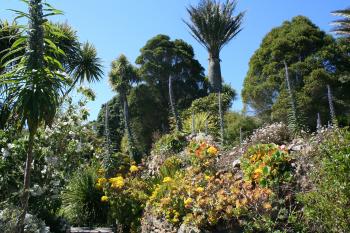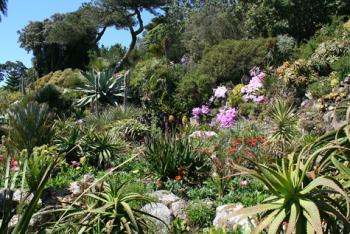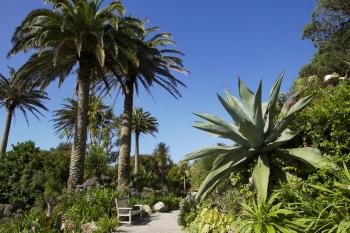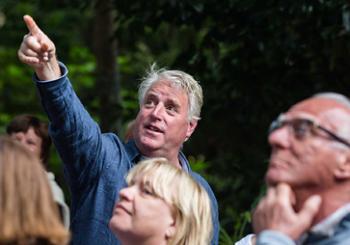Tresco Abbey Garden, Isles of Scilly
This item appears on page 43 of the May 2019 issue.
In the early-morning light of May 2018, Grand Circle Cruise Line’s M/V Corinthian dropped anchor off Tresco in the Isles of Scilly archipelago. (See my article “Maritime Jewels — Cruising the British Isles & Ireland” in the October 2018 issue.)
Once the landing platform was launched, the ship’s tender sped off toward Tresco on a mission to fetch Mike Nelhams, curator of the island’s near-subtropical Abbey Garden that we’d come to see.
The setting
With all passengers aboard gathered in the lounge, the witty and affable Mike filled us in not only on details about the garden but on what it is like to live on that tiny dot of land 30 miles off the Cornwall coast.
Mike first went to Tresco in 1976 as a horticultural-scholarship student, returned in 1984 as head gardener and was named curator a few years later.
Tresco is the second largest of the five inhabited Isles of Scilly, out of an archipelago count of 145. “If it’s big enough to sit on when the tide’s out, we call it an island,” Mike told us. The total population of those inhabited is 2,203, of which St. Mary’s, the biggest island, claims 1,500. “That doesn’t leave a lot left over for the rest of us. About 200 for Tresco.”
That number swells considerably with seasonal day visitors, we learned, most flying from Cornwall to St. Mary’s and making their way by ferry to Tresco.
“And last year we had passengers cluttering up the place from 75 cruise ships come to call,” Mike said, adding with a smile, “Well, you’re here. That’s OK.”
Abbey Garden is Tresco’s star visitor attraction. Mike described it as like no other in Britain and possibly Europe. In its 17 acres grow some 20,000 plants representing 6,000 species from 80 temperate coastal regions all over the world.
Mike has the last say as to which plants stay, go or are introduced. “I’m a gardener,” he said. “I like plants that look good, have flowers. I’m not interested in something that’s one-inch tall and doesn’t do anything, just because it’s obscure.”
Every year, in the dead-of-winter January, Mike, along with the head gardener and horticultural students, makes a count of plants in flower, a number that invariably fluctuates on either side of 300.
Except for January 1987. A siege of icy weather of a severity virtually unheard of on the archipelago settled in.
“Nearly the entire garden turned into stewed rhubarb and smelled a lot worse,” Mike related.
Replacement entailed contacting gardens throughout Britain to see what they might share, with the Royal Botanic Gardens, Kew, in particular, chipping in. More plant material was gathered on horticultural trips to the various Mediterranean climate zones of the world. California, Australia, New Zealand, South America, South Africa. . . .
With that, we were off by ship’s tender to explore what Mike described as “Kew without its glass lid.”
The experience
For nearly 700 years, the Isles of Scilly have pledged allegiance to king and country via the Duchy of Cornwall, today flying under the wings of Prince Charles.
Tresco, unlike the other islands, has long been leased. Today, the Dorrien-Smith family is in its fourth generation of caring for the garden, created in 1834 by then lease-holder Augustus Smith around the ruins of an old Benedictine abbey.
It was Smith who conceived of planting a surrounding, towering, shelterbelt stand of tough evergreen trees able to shrug off salt air and stormy Atlantic gales as a means of protecting the expanding collection of tender plants in his private garden.
We walked paths crisscrossing terraces of varying elevations, with plants of sumptuous size on either side — towering palms, giant lipstick-red flame trees, agaves, proteas, grevilleas….
Chinese pheasants strutted by. A red squirrel made a derring-do jump from a Monterey pine. The squirrels, introduced as a pair in 2012 at the suggestion of Prince Charles, have increased to more than 60 to Mike’s dismay. A favored food of theirs is flowers.
As if the garden’s lush diversity were not enough, an “Italianette-style” addition was recently installed. Conceived by current owner Robert Dorrien-Smith as an entrance centerpiece, its formal balustrades, terra-cotta urns and fountain struck me as jarring to the spirit of the garden.
Too, while applauding Augustus Smith’s dense shelterbelt, I wished that it had windows. As I wandered the paths, I longed to view the sea as a reminder that this astounding collection of thriving subtropical plants exists on a dot in the wild Atlantic.
And wild the Atlantic can be, as evidenced by the Valhalla Museum situated in a far corner of the garden. Augustus Smith began a collection that today displays 30 figureheads, along with other salvaged decorative carvings, from 19th-century sailing ships downed on Scillies rocks.
A wild Atlantic was left to the imagination as we tendered back to the Corinthian on calm, Caribbean-hued seas. A fitting goodbye to Tresco’s horticultural paradise.
The Tresco Abbey Garden (Tresco, Isles of Scilly, TR24 0QQ, U.K.; phone +44 [0] 1720 424108, tresco.co.uk/enjoying/abbey-garden) is open daily from 10 a.m. to 4 p.m., though the visitor center closes during winter. Admission costs £15 (near $20), adult.
Email Yvonne Michie Horn at yhorn@sonic.net. Also visit www.thetravelinggardener.com.

_rgb-itok=-h1Gx0l9.jpg)
_rgb-itok=fuIM1ooP.jpg)



